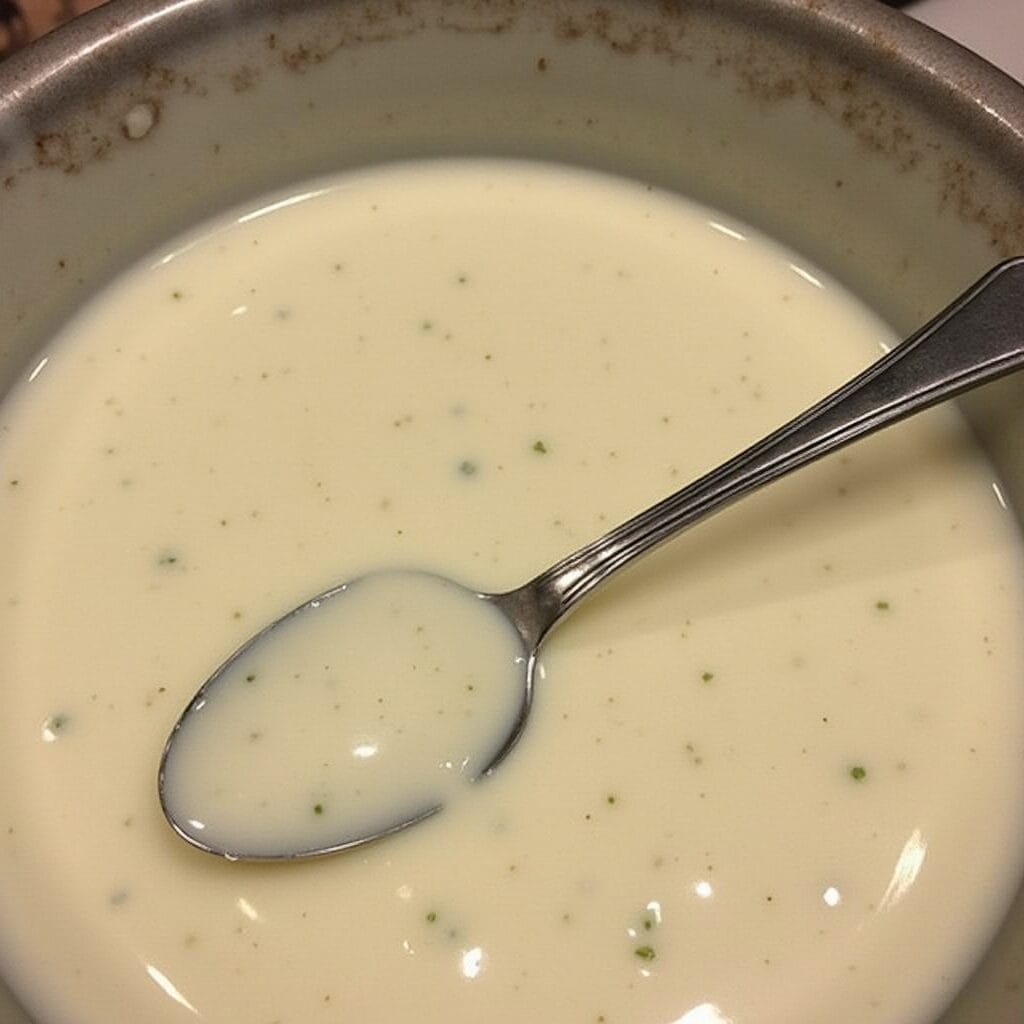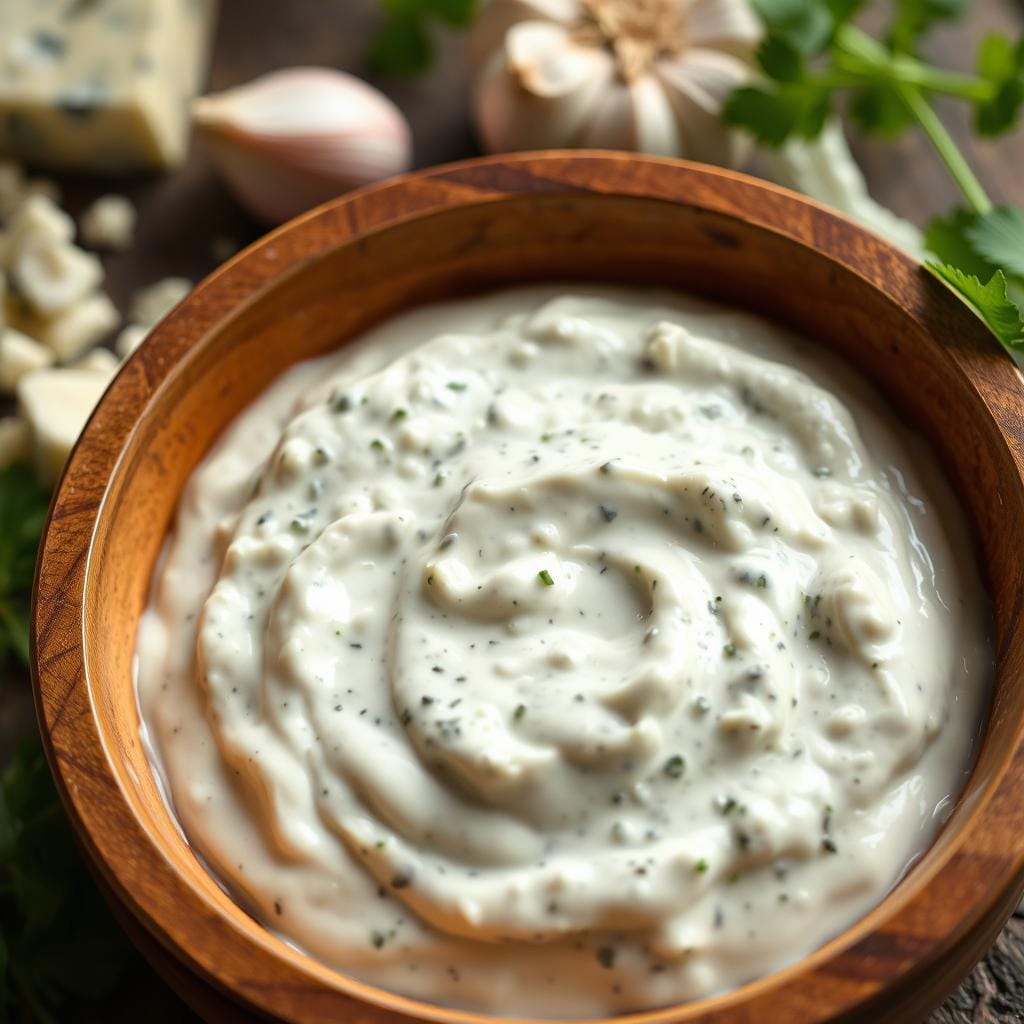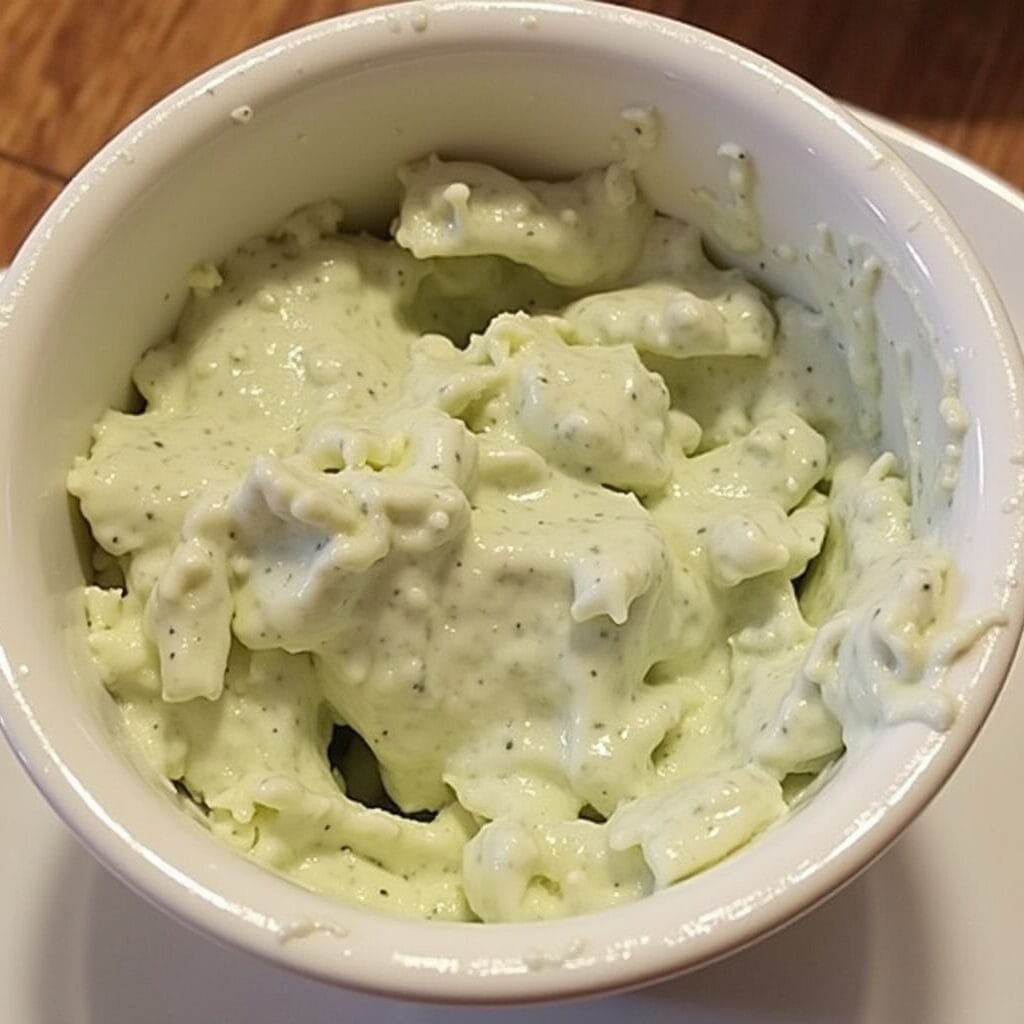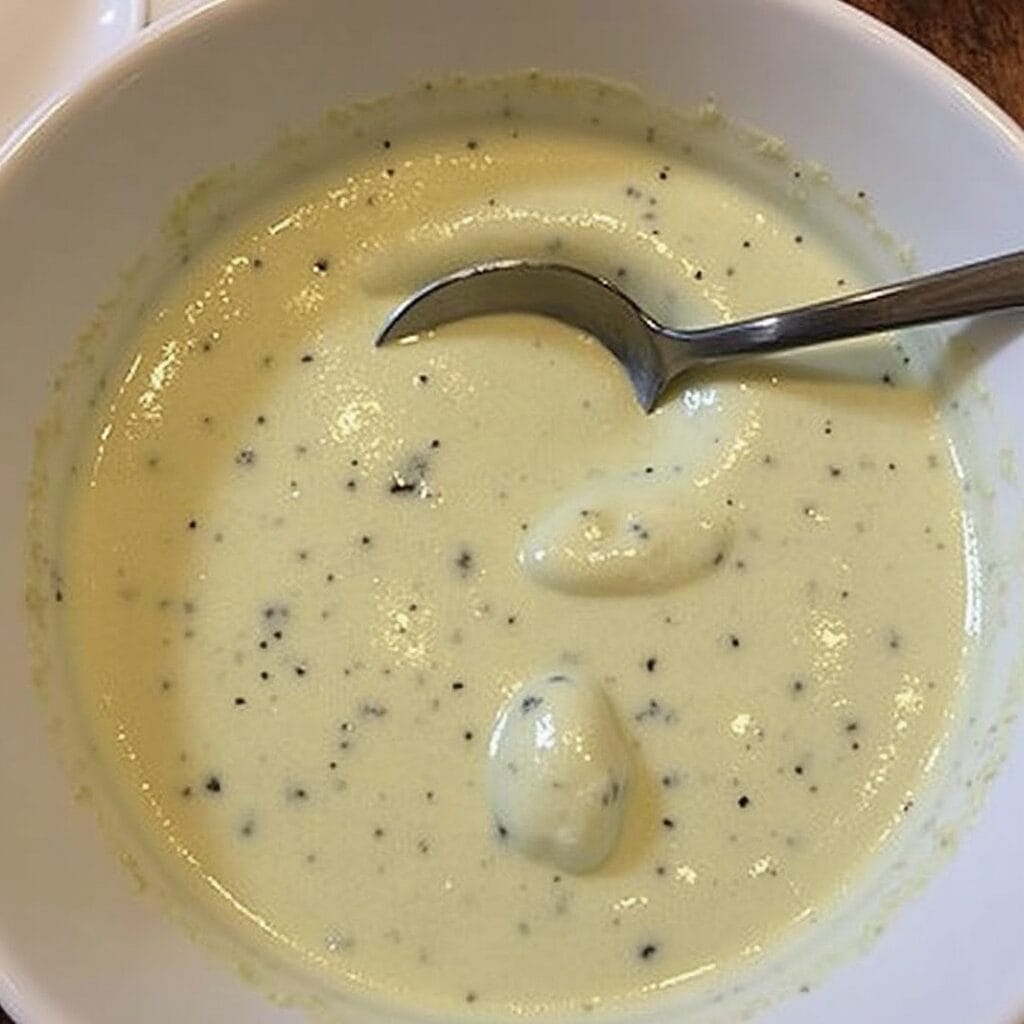I love the creamy taste of blue cheese dressing. It makes any salad or veggie dip better. But, have you ever thought about where restaurants get their blue cheese dressing? The answer might surprise you.
We’ll explore how blue cheese dressing became a favorite in American restaurants. You’ll learn about its history and how it’s made today. This will make you appreciate the effort that goes into making this tasty sauce.

Key Takeaways
- Restaurants get their blue cheese dressing from many places, like distributors and local suppliers.
- The story of blue cheese dressing started with old recipes. Today, it’s made in new ways too.
- Keeping blue cheese dressing safe and fresh is key. This includes following FDA rules and keeping it at the right temperature.
- Restaurants buy in bulk and customize their dressing to save money and improve taste.
- Good supply chain management helps restaurants keep a steady supply of blue cheese dressing.
Quesillo, a Mexican cheese, pairs well with blue cheese dressing. Learning about quesillo can help us understand the traditions behind this dressing.
The Origins and Evolution of Restaurant Blue Cheese Dressing
Blue cheese dressing has been a favorite on restaurant menus for years. It adds a tangy flavor to salads, veggies, and chicken wings. The story of this dressing starts in the early 1900s, when chefs mixed blue cheese with other ingredients to make a new salad dressing.
Historical Development of Blue Cheese Dressing
In the 1920s and 1930s, the first blue cheese dressing recipes appeared. They used blue cheese, mayonnaise, sour cream, and herbs. These dressings quickly became popular in fancy and casual places in the U.S.
Traditional Recipe Components
The classic blue cheese recipes include:
- Crumbled blue cheese (like Roquefort, Gorgonzola, or Stilton)
- Mayonnaise
- Sour cream
- Lemon juice or vinegar
- Garlic, onion, or other aromatic herbs and spices
Modern Adaptations in Restaurants
Over time, cheese-based condiments like blue cheese dressing have changed. Restaurants now offer new flavors, like spicy cayenne pepper or fresh herbs. Some chefs use Greek yogurt for a healthier version of the classic salad dressing ingredients.

Even with these changes, blue cheese dressing still offers a rich, creamy taste. It’s a favorite in restaurants all over the country.
Major Commercial Suppliers and Manufacturers
In the world of restaurant dressings, the dressing manufacturing process is key. Leading suppliers have mastered making tasty and consistent blue cheese dressings. They are the top choice for many restaurants.
Kraft Heinz is a big name in the industry. They offer a wide range of dressings, including blue cheese. Their focus on quality and efficient process makes them a favorite among chefs and restaurant owners.
Ken’s Foods is another well-known supplier. This family business has been making top-notch dressings for over 60 years. Their blue cheese dressing, with real blue cheese, is a favorite in many kitchens.
| Supplier | Product Offerings | Signature Features |
|---|---|---|
| Kraft Heinz | Wide range of dressings, including Blue Cheese | Focus on quality ingredients, streamlined manufacturing process |
| Ken’s Foods | Blue Cheese Dressing, among other offerings | Family-owned, 60+ years of experience, real blue cheese chunks |
| Hidden Valley | Blue Cheese Dressing, Ranch Dressing | Consistent flavor, trusted brand reputation |
Hidden Valley is also a big name. They are known for their tasty blue cheese dressing and other favorites like ranch.
These top manufacturers have perfected the dressing-making process. Restaurants can count on them for a reliable and delicious supply of blue cheese dressing.

“The key to a great blue cheese dressing is the perfect balance of creamy, tangy, and savory flavors, and these commercial suppliers have truly nailed it.” – Executive Chef, ABC Restaurant
Where Do Restaurants Get Their Blue Cheese Dressing?
Restaurants have many ways to get their blue cheese dressing. They can work directly with distributors, use wholesale providers, or support local suppliers. Each method has its own benefits and challenges.
Direct Distributor Relationships
Many restaurants prefer to work directly with distributors. They focus on high-quality dairy products, like blue cheese dressing. This way, they can get better prices, ensure quality, and have a steady supply.
Wholesale Food Service Providers
Wholesale providers are also a common choice. They offer a wide range of products, including blue cheese dressing. Restaurants get good prices and the ease of ordering and delivery.
Local Supplier Networks
Supporting local suppliers is another option. It helps restaurants get blue cheese dressing while supporting their community. This approach often means better flavor and more control over ingredients.
| Sourcing Method | Advantages | Challenges |
|---|---|---|
| Direct Distributor Relationships | – Customized pricing – Consistent quality – Reliable supply chain | – Limited product selection – Potentially higher costs |
| Wholesale Food Service Providers | – Wide product selection – Competitive pricing – Centralized ordering | – Less personalized service – Potential for inconsistent quality |
| Local Supplier Networks | – Support for local economy – Unique regional flavors – Transparency in sourcing | – Limited availability – Potentially higher costs |
Choosing where to get blue cheese dressing depends on a restaurant’s needs and budget. By weighing the pros and cons, they can offer the best blue cheese dressing to their customers.
Making Blue Cheese Dressing In-House vs. Purchasing Ready-Made
Restaurants face a choice when it comes to creamy dressings like blue cheese. They can make it themselves or buy it ready-made. Each option has its own benefits and things to consider.
Making artisan cheese dressings in-house lets you control the quality and flavor. It’s a hands-on process that can take time and need special skills. But, buying pre-made blue cheese dressing can save on labor and ensure a consistent taste.
| In-House Production | Purchasing Ready-Made |
|---|---|
|
|
The choice to make or buy creamy dressings depends on your restaurant’s needs and goals. Weighing the pros and cons can help you decide what’s best for your place.
“The key to a great blue cheese dressing is finding the right balance of tang, creaminess, and texture. It’s a delicate dance that takes time to perfect in-house.”
Quality Standards and Storage Requirements
Ensuring food safety and maintaining quality is key for restaurant blue cheese dressing. Restaurants must follow strict food safety rules set by the FDA. This is to protect customers and keep their reputation high.
FDA Regulations for Dairy-Based Dressings
The FDA watches over the making, handling, and storage of dairy dressings like blue cheese. Restaurants must follow rules for temperature, ingredient sources, and food prep. This is to meet these high standards.
Temperature Control Guidelines
- Keep blue cheese dressing at a steady temperature between 40°F and 140°F to stop bacteria from growing.
- Store it in the fridge and don’t let it sit at room temperature for too long.
- Check and write down the dressing’s temperature often to keep food safe.
Shelf Life Management
Storing and handling dressing right is key to keeping blue cheese dressing fresh. Restaurants should stick to storage times and throw away dressing past its expiration date.
“Keeping strict quality control and food safety rules is vital for restaurants with blue cheese dressing. Following FDA rules and temperature guidelines means customers get a tasty and safe product every time.”
Cost Analysis: Bulk Purchasing vs. Small Batch Production
Running a restaurant means managing costs all the time. Deciding whether to buy blue cheese dressing in bulk or make it yourself affects your budget. Let’s look at the costs to help you choose wisely.
Ingredient Costs
Buying ingredients in bulk can save a lot of money. You can get better deals by buying more. But, making it yourself lets you control the recipe and quality better.
Labor and Equipment Expenses
Making dressing yourself costs money for labor, equipment, and storage. It might seem expensive at first. But, it lets you adjust the dressing to what your customers like. Buying it ready-made saves on staff and equipment but might not let you stand out.
Waste Management
Buying in bulk can lead to waste if the dressing doesn’t last long or if demand changes. Making it yourself helps you keep track of how much you have. This way, you can avoid waste and keep the dressing fresh.
| Factor | Bulk Purchasing | Small Batch Production |
|---|---|---|
| Ingredient Costs | Lower per unit, but higher overall | Higher per unit, but more control over quality |
| Labor and Equipment | Reduced, but less flexibility | Higher, but greater customization |
| Waste Management | Potential for higher waste if demand fluctuates | Tighter control over inventory and freshness |
The choice between buying in bulk or making your own blue cheese dressing depends on several factors. You need to consider cost, quality, and how flexible you want to be. By understanding your specific needs, you can find the best way to keep your customers happy and your business profitable.
Popular Brands Used by Professional Kitchens
Restaurants often choose well-known commercial brands for blue cheese dressing. These brands are trusted by chefs and used widely. They ensure consistent flavor and quality.
Top-Rated Commercial Options
Brands like Kraft, Hidden Valley, and Ken’s Steak House are favorites. They offer a mix of tangy blue cheese and creamy texture. This makes them perfect for many dishes.
Chef-Recommended Selections
Some chefs prefer regional or specialty restaurant dressing brands. They look for brands like Litehouse, Marzetti, and Marie’s. These are known for their real flavors and quality ingredients.
The choice of blue cheese dressing brand depends on taste, menu, and cost. Knowing the popular options helps restaurants improve their dishes. It also meets customers’ love for this condiment.
“The right blue cheese dressing can truly elevate a salad or transform a classic burger. It’s a versatile ingredient that deserves careful consideration in any professional kitchen.”
– Chef Samantha Wilkins, Culinary Institute of America
Customization Techniques for Restaurant-Specific Flavors
Restaurants can make their blue cheese dressings stand out by customizing them. They can tweak the flavors to match their menu and what their customers like. This way, they can offer something special that sets them apart in a crowded market.
One way to customize is by changing how much blue cheese and creamy ingredients are used. More blue cheese makes the dressing bold and rich. More creamy ingredients make it smooth and mild, perfect for lighter dishes.
Restaurants can also add extra flavors to make their dressings unique. Artisan cheese dressings might get herbs, spices, or roasted garlic. Blue cheese recipes could get a hint of citrus, honey, or a spicy kick from chili peppers.
| Customization Technique | Potential Benefits |
|---|---|
| Adjusting Blue Cheese to Mayonnaise/Sour Cream Ratio | Creates a bolder or creamier dressing to align with menu concept |
| Incorporating Additional Flavors (herbs, spices, garlic, citrus, etc.) | Develops a signature flavor profile that sets the restaurant apart |
| Experimenting with Unique Ingredient Combinations | Offers guests a distinctive dining experience through innovative flavors |
Understanding the restaurant’s brand and what customers want is key. By finding the right mix of classic and unique flavors, restaurants can create a signature dressing. This dressing becomes a key part of their menu and what makes them special.
Supply Chain Management for Restaurant Dressings
Keeping a steady supply of top-notch blue cheese dressing is vital for any restaurant’s success. Good supply chain management and food inventory management are essential. They help make sure your kitchen always has this key condiment.
Let’s look at the best ways to improve your dressing supply chain.
Inventory Control Systems
Starting with a solid inventory control system is key. You might use digital tools to track how much you use, keep an eye on stock, and send alerts when it’s time to order more. This way, you can avoid running out and cut down on waste.
By managing your restaurant supply chain well, you can keep your blue cheese dressing supply steady.
Ordering Schedules and Planning
Having a regular ordering schedule is important. Think about when you use the most dressing, how long it lasts, and how long it takes to get from your suppliers. This helps you order just the right amount.
For better food inventory management, consider just-in-time ordering, buying in bulk, and building strong relationships with your suppliers. These strategies can make your supply chain more efficient, save you money, and keep your customers happy with their blue cheese dressing.
“Successful restaurant supply chain management is the backbone of any thriving food service business.”
Conclusion
Discovering how to source and manage blue cheese dressing in restaurants is complex. It involves understanding its history and evolution. You also need to look at different suppliers and manufacturers.
Whether you make it yourself or buy it, keeping quality high is key. You must also store it properly. This helps you balance costs and manage your supplies well.
This article has given you the tools to improve your blue cheese dressing. By following these tips, you can meet your customers’ changing tastes. Good blue cheese dressing management boosts your restaurant’s success and profits.


1 thought on “Where Do Restaurants Get Their Blue Cheese Dressing?”